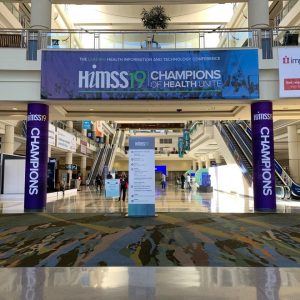The Healthcare Information and Management Systems Society (HIMSS) – the leading health informatics professional organization – hosted their annual conference between March 14 – 18, 2022. HIMSS22 offered a digital conference in addition to an onsite event held at the Orange County Convention Center in Orlando, FL, which included its own exclusive content and speakers. This year’s theme was “Reimagine Health”.
Just under 29,000 people attended alongside over 1,000 exhibitors. The conference included seminars, training sessions, panel discussions and chances to meet with CEOs, COOs and other influential people in the world of health informatics.
What is HIMSS?
HIMSS is a leading, global member-based society that aims to reimagine healthcare on a global scale through information technology. The community firmly believes that when it comes to healthcare, knowledge is power, and they hope to assist healthcare providers improve patient care by improving access to vital healthcare data and information. This year’s conference, HIMSS22, was no different – speakers broached some critical issues of the healthcare industry.
Cybersecurity and Patient Data Privacy
As technology advances, so does cybercrime. The healthcare industry is no exception. To safely and effectively treat patients, healthcare professionals must have easy access to protected health information (PHI). These medical records are a prime target for hackers who seek private information for devious reasons.
On an ethical level, it is vital that PHI is kept secure and private. On a practical level, patients need to know that records remain confidential, elsewise they may omit critical pieces of medical history. And on a legal level, legislation such as HIPAA demands the utmost security and confidentiality of patient data. HIMSS22 featured many sessions addressing issues of cybersecurity and patient privacy.
Zero Trust Security in Healthcare
A Practical Approach to Zero Trust Security in Healthcare, presented by Greg Murphy – CEO of Ordr, and Christopher Kuhl – CISO/CTO of Dayton Children’s Hospital – this session highlighted the sheer number of connected medical devices in comparison to traditional network devices like laptops. The reality is that each of these devices can easily become a threat vector in case of a cyberattack.
With static inventories, outdated legacy equipment and operating systems, varying protocols and inconsistent organizational ownerships – among other concerns – it’s difficult to fend off cyberattacks. Murphy and Kuhl proposed a practical way to adopt something called Zero-Trust Security.
To summarize, implementation requires that all devices are accessed by participants securely, only the exact people who need-to-know have access, activity must be verified with traffic monitored and networks should be designed from the inside out. Doing so prevents events like ransomware infiltrating the network which may lead to actual patient harm.
Ransomware in Healthcare
Speaking of ransomware, Kevin Tambascio – Manager of Cybersecurity at Cleveland Clinic – and Srinivas Loke – Senior Director of Product Management at Ordr – set out to explicitly address the impacts of ransomware on the healthcare industry.
Aptly titled Battling Ransomware in Healthcare, they started off by identifying tangible impacts: 26.4 million U.S. healthcare records were breached in 2020 and many organizations did not notice for months. When talking economic impact, up to $7 billion is spent on lost or stolen PHI annually. In terms of patients, ransomware may result in incorrect ambulance direction, slowed medical procedures and delayed care.
Attendees walked away from both sessions with step-by-step recommendations to implement improvements in cybersecurity.
The Use of Analytics to Advance Healthcare
The massive amounts of data collected in the healthcare industry would be completely unmanageable without the discipline of healthcare analytics. Exactly who – and how – the data is processed varies by organization and changes as technology itself improves.
Analytics and Care Management
Local organization Orlando Health appeared at HIMSS22 with the session How Data and Analytics Can Transform Care Management. Presented by Katherine Dixon, MHA, CPC, COC – Director, Population Health Operations and Optimization – and Claire Goodwin, MHA – Senior Director of Strategy and Business Development – the session sought to show how data analytics can strengthen comprehensive care management.
With the acknowledgement that data can feel overwhelming, they proposed a clear six-step process to successful implementation of data-driven care management:
- Define the goal or purpose.
- Build relationships.
- Secure funding.
- Establish data governance.
- Define data requirements.
- Establish technical and analytical infrastructure.
They then gave a detailed summary of how the concept was implemented to address readmission rates in the Orlando Health system. The result? A successful drop in readmission rates of just over 3%, among other improvements.
Prescriptive Analytics and Inventory Management
Where Orlando Health analyzed existing data to make their improvements for patient care directly, two other organizations collaborated on tackling inventory control and supply concerns. Samantha Bastow, PharmD, MBA – Senior Manager of Medical Affairs at Becton Dickinson – and Megan Park, PharmD, MBA, DPLA – System Director of Clinical Pharmacy Informatics at Intermountain Healthcare – presented the use of predictive and prescriptive data analysis.
They identified the struggle between meeting demands of excellent patient care while minimizing wasted costs of excess medication and medical devices. The balance, they claim, may be found using data analysis correctly. To do this requires a move away from the traditional descriptive analytics toward, first, predictive analytics and finally prescriptive analytics.
Prescriptive analytics:
- Is forward thinking.
- Able to identify inventory issues in near-real time.
- Adjust action quickly.
Machine learning and artificial intelligence were cited as examples.
Ethics and Bias in Artificial Intelligence
Though some initially felt that AI in healthcare would ease concerns of bias and ethical issues in the healthcare industry, programs are still fallible by virtue of being created by humans. As the use of AI increases – and AI itself matures – these concerns are at the forefront of decision-making efforts. HIMSS22 was no different, featuring a variety of AI-themed sessions.
Ethical AI and Digital Health
Muhammad Babur, MBA, MS – Instructor of Health Care Administration and Program Manager of IT at Mayo Clinic – was quick to stress that a virtual AI doctor would not replace human doctors. Rather, they’re meant to complement their human counterparts and enhance their ability to provide improved patient care. Preliminary data showed that patients are willing to use AI-powered health services because of the convenience they offer.
However, there are critical issues with biases in AI. These issues have very real societal, legal and monetary implications that need to be addressed. One example is a health risk-prediction algorithm used on more than 200 million people in the U.S. It demonstrated racial bias, as it relied on a faulty metric.
In addition to other safeguards, Babur stated a clear need for human oversight of AI.
AI Regulation in Healthcare
Babur was not the only one present at HIMSS22 calling for official regulations. Brian Scarpelli – Senior Global Policy Counsel at Connected Health – and Sebastian Holst – Principal at Qi-Fense – brought a compelling argument in favor of such regulations.
While recognizing the benefits of AI to patient care, they identified common areas of concern where bias and human error appears. These areas include machine training errors, distribution failures and operational vulnerabilities. They call for revision of existing regulations to consider the impact of machine learning and AI, as well as the creation of other regulations and regulatory bodies going forward.
Looking Toward 2023
These concerns will no doubt span the years to come, evolving as technology evolves. HIMSS23 is set for Chicago, IL, between April 17 – 21 and will likely tackle similar topics that we’ve discussed here. For those of you who feel strongly about addressing any of them, we encourage you to take a closer look at USF Health’s MS in Health Informatics.



